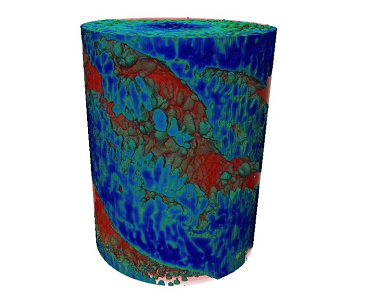
An innovative method for aluminium recycling has been boosted by research showing the microscopic changes that take place when molten alloys cool.
Researcher Dr Biao Cai from the University of Birmingham’s School of Metallurgy and Materials used sophisticated high-speed X-ray imaging to record the formation of micro-crystals as alloys cool and solidify, under a magnetic field.
A mathematical model was developed by his collaborator Dr Andrew Kao from the University of Greenwich to predict whether micro-crystals would form, and what shape they would have.
The model predicted that that helical ‘screw-like’ crystals would form under the influence of strong magnetic stirring, and the high-speed X-ray confirmed that this occurred.
Although these elegant crystals are just micro-meters wide (ten times smaller than a human hair), they have implications for industrial-scale processes.
Biao explains: “These microscopic crystals ultimately determine the physical properties of the alloy. To be able to adjust their shape, structure and direction of growth will enable us to perfect processes for both manufacturing and recycling of metals and alloys”.
Biao has already invented technique to improve aluminium recycling by removing iron. Iron is a detrimental element that can make aluminium brittle, and limit its use in premium applications such as aircraft.
Existing methods for removing iron during recycling are either expensive or inefficient, but Biao’s simple, inexpensive technique uses magnets and a temperature gradient to remove iron contamination.
The invention has been patented by University of Birmingham Enterprise, and supported by the Midlands Innovation Commercialisation of Research Accelerator which awarded Biao a grant to build a large-scale prototype.
ENDS
For further media information contact Ruth Ashton, University of Birmingham Enterprise, email: r.c.ashton@bham.ac.uk
For commercial information, or enquiries about IP contact Alan Tibbatts, University of Birmingham Enterprise, email: a.tibbatts@bham.ac.uk
Cai et al (2020). Revealing the mechanisms by which magneto-hydrodynamics disrupts solidification microstructures. Acta Materialia. https://doi.org/10.1016/j.actamat.2020.06.041
Notes to editors
Dr Biao Cai collaborated with scientists at University College London, the University of Greenwich, and the Diamond Light Source and European Synchrotron Radiation Facility on the high-speed X-ray tomography.
University of Birmingham Enterprise helps students and researchers turn their ideas into new services, products and enterprises that meet real-world needs. We also support innovators and entrepreneurs with mentoring, advice, and training and manage the University’s Academic Consultancy Service.
About aluminium recycling
- Each year tens of million tonnes of aluminium are produced for transportation, packaging, construction, and electrical appliances and household items.
- Recycling aluminium uses 10% of the energy, and releases just 5% of the CO2 compared primary aluminium production.
- Aluminium can be recycled forever: It can be melted down and reformed without losing any quality, and the process can be repeated over and over again.